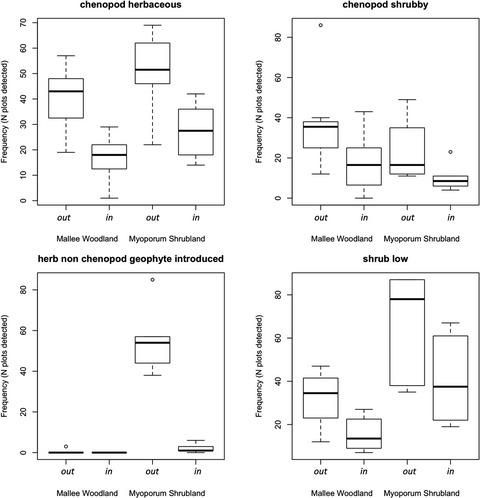当前位置:
X-MOL 学术
›
Austral Ecol.
›
论文详情
Our official English website, www.x-mol.net, welcomes your
feedback! (Note: you will need to create a separate account there.)
Consequences of the reintroduction of regionally extinct mammals for vegetation composition and structure at two established reintroduction sites in semi‐arid Australia
Austral Ecology ( IF 1.6 ) Pub Date : 2021-03-16 , DOI: 10.1111/aec.13022 Jeanette E. Kemp 1 , Rigel Jensen 1 , Michelle L. Hall 1, 2, 3 , David A. Roshier 1 , John Kanowski 1
Austral Ecology ( IF 1.6 ) Pub Date : 2021-03-16 , DOI: 10.1111/aec.13022 Jeanette E. Kemp 1 , Rigel Jensen 1 , Michelle L. Hall 1, 2, 3 , David A. Roshier 1 , John Kanowski 1
Affiliation

|
Australia has lost a substantial proportion of its small to medium‐sized mammals since European colonisation. Given the passage of time since local extinctions – decades to more than a century for much of the continent – the consequences of these changes for vegetation are poorly known. In this study, we take advantage of two well‐established mammal reintroduction projects in southern inland Australia to examine the ecological consequences for vegetation of re‐established mammal populations. The study is based on replicated surveys inside and outside fenced reintroduction sites, with treatments characterised by varying presence, absence and composition of reintroduced mammals, feral predators and feral herbivores. We found a suite of differences in vegetation between reintroduction sites and matched controls, with generally lower richness inside reintroduction sites (with one exception). Other compositional differences varied by location, with some functional groups – herbaceous chenopods, shrubby chenopods, introduced geophytes and low shrubs – and a few individual chenopod species – being less frequent inside the reintroduction site at one location. At the same site, mistletoes and orchids were less abundant inside than outside the reintroduction site. Structural differences included a higher percentage of bare ground inside, and a higher ground layer for one inside treatment versus outside. Although the absence of baseline data and replicated temporal data limits inference as to causal factors, many of the results are consistent with data from other reintroduction sites. Some results, especially those for geophytes, mistletoes and some chenopods, may indicate long‐term consequences for those taxa. Whilst predator‐fencing substantially contributes to prevention of extinction of highly threatened mammals, some environmental trade‐offs are inevitable. Nonetheless, given the aims of reintroductions include re‐constructing natural ecosystem processes, the resulting changes to vegetation require ongoing investigation and further monitoring.
中文翻译:

在澳大利亚半干旱地区两个已建立的重新引入地点,对已灭绝的哺乳动物重新引入植被组成和结构的后果
自欧洲殖民以来,澳大利亚已经失去了很大一部分中小型哺乳动物。考虑到自局部灭绝以来的时间流逝(整个大陆的大部分地区长达数十年到一个世纪以上),这些变化对植被的后果知之甚少。在这项研究中,我们利用澳大利亚南部内陆的两个成熟的哺乳动物再引入项目来研究重新建立的哺乳动物种群对植被的生态影响。该研究基于围栏式再引入地点内外的重复调查,其处理的特征是再引入的哺乳动物,野生捕食者和野生草食动物的存在,不存在和组成不同。我们发现了引种点和匹配的对照之间的植被差异,重新引入位点内的丰富度通常较低(一个例外)。其他组成差异随位置而异,其中某些功能组-草本藜科动物,灌木类藜科动物,引入的水生植物和低矮灌木-以及少数单个藜科动物种类-在一个位置的再引入地点内的频率较低。在同一地点,槲寄生和兰花在重新引入地点内比在外地点少。结构上的差异包括内部裸露地面的百分比较高,以及一个内部处理相对于外部而言较高的接地层。尽管没有基准数据和重复的时间数据限制了因果关系的推断,但许多结果与其他重新引入位点的数据一致。一些结果,特别是对于那些水生植物,槲寄生和一些藜科动物的结果,可能表明这些分类单元的长期后果。捕食者围栏在很大程度上有助于预防高度威胁的哺乳动物的灭绝,但在环境上的取舍是不可避免的。尽管如此,鉴于重新引入的目的包括重建自然生态系统过程,因此对植被造成的变化需要进行持续调查和进一步监测。
更新日期:2021-05-15
中文翻译:

在澳大利亚半干旱地区两个已建立的重新引入地点,对已灭绝的哺乳动物重新引入植被组成和结构的后果
自欧洲殖民以来,澳大利亚已经失去了很大一部分中小型哺乳动物。考虑到自局部灭绝以来的时间流逝(整个大陆的大部分地区长达数十年到一个世纪以上),这些变化对植被的后果知之甚少。在这项研究中,我们利用澳大利亚南部内陆的两个成熟的哺乳动物再引入项目来研究重新建立的哺乳动物种群对植被的生态影响。该研究基于围栏式再引入地点内外的重复调查,其处理的特征是再引入的哺乳动物,野生捕食者和野生草食动物的存在,不存在和组成不同。我们发现了引种点和匹配的对照之间的植被差异,重新引入位点内的丰富度通常较低(一个例外)。其他组成差异随位置而异,其中某些功能组-草本藜科动物,灌木类藜科动物,引入的水生植物和低矮灌木-以及少数单个藜科动物种类-在一个位置的再引入地点内的频率较低。在同一地点,槲寄生和兰花在重新引入地点内比在外地点少。结构上的差异包括内部裸露地面的百分比较高,以及一个内部处理相对于外部而言较高的接地层。尽管没有基准数据和重复的时间数据限制了因果关系的推断,但许多结果与其他重新引入位点的数据一致。一些结果,特别是对于那些水生植物,槲寄生和一些藜科动物的结果,可能表明这些分类单元的长期后果。捕食者围栏在很大程度上有助于预防高度威胁的哺乳动物的灭绝,但在环境上的取舍是不可避免的。尽管如此,鉴于重新引入的目的包括重建自然生态系统过程,因此对植被造成的变化需要进行持续调查和进一步监测。











































 京公网安备 11010802027423号
京公网安备 11010802027423号